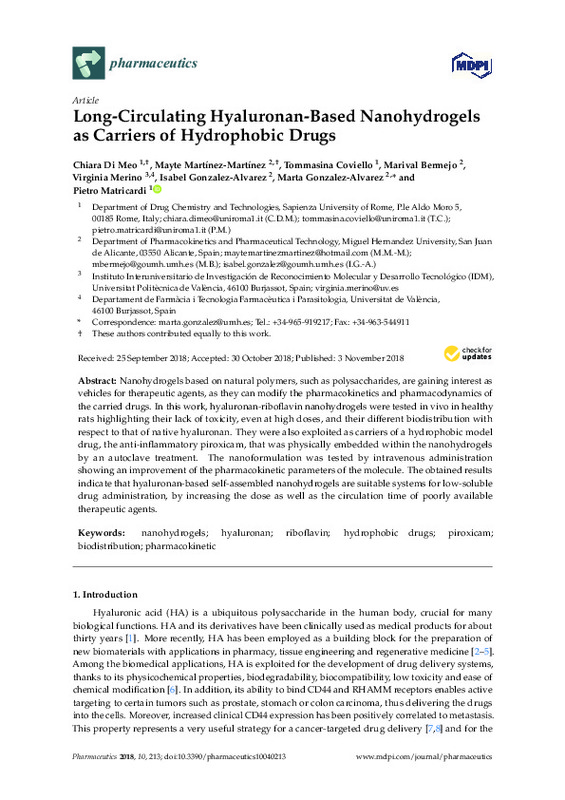Allison, D. D., & Grande-Allen, K. J. (2006). Review. Hyaluronan: A Powerful Tissue Engineering Tool. Tissue Engineering, 12(8), 2131-2140. doi:10.1089/ten.2006.12.2131
Prestwich, G. D. (2008). Engineering a clinically-useful matrix for cell therapy. Organogenesis, 4(1), 42-47. doi:10.4161/org.6152
Ossipov, D. A. (2010). Nanostructured hyaluronic acid-based materials for active delivery to cancer. Expert Opinion on Drug Delivery, 7(6), 681-703. doi:10.1517/17425241003730399
[+]
Allison, D. D., & Grande-Allen, K. J. (2006). Review. Hyaluronan: A Powerful Tissue Engineering Tool. Tissue Engineering, 12(8), 2131-2140. doi:10.1089/ten.2006.12.2131
Prestwich, G. D. (2008). Engineering a clinically-useful matrix for cell therapy. Organogenesis, 4(1), 42-47. doi:10.4161/org.6152
Ossipov, D. A. (2010). Nanostructured hyaluronic acid-based materials for active delivery to cancer. Expert Opinion on Drug Delivery, 7(6), 681-703. doi:10.1517/17425241003730399
Rao, N. V., Yoon, H. Y., Han, H. S., Ko, H., Son, S., Lee, M., … Park, J. H. (2015). Recent developments in hyaluronic acid-based nanomedicine for targeted cancer treatment. Expert Opinion on Drug Delivery, 13(2), 239-252. doi:10.1517/17425247.2016.1112374
Dosio, F., Arpicco, S., Stella, B., & Fattal, E. (2016). Hyaluronic acid for anticancer drug and nucleic acid delivery. Advanced Drug Delivery Reviews, 97, 204-236. doi:10.1016/j.addr.2015.11.011
Montanari, E., D’Arrigo, G., Di Meo, C., Virga, A., Coviello, T., Passariello, C., & Matricardi, P. (2014). Chasing bacteria within the cells using levofloxacin-loaded hyaluronic acid nanohydrogels. European Journal of Pharmaceutics and Biopharmaceutics, 87(3), 518-523. doi:10.1016/j.ejpb.2014.03.003
Svanovsky, E., Velebny, V., Laznickova, A., & Laznicek, M. (2008). The effect of molecular weight on the biodistribution of hyaluronic acid radiolabeled with111In after intravenous administration to rats. European Journal of Drug Metabolism and Pharmacokinetics, 33(3), 149-157. doi:10.1007/bf03191112
Harris, E. N., Kyosseva, S. V., Weigel, J. A., & Weigel, P. H. (2006). Expression, Processing, and Glycosaminoglycan Binding Activity of the Recombinant Human 315-kDa Hyaluronic Acid Receptor for Endocytosis (HARE). Journal of Biological Chemistry, 282(5), 2785-2797. doi:10.1074/jbc.m607787200
Choi, K. Y., Min, K. H., Na, J. H., Choi, K., Kim, K., Park, J. H., … Jeong, S. Y. (2009). Self-assembled hyaluronic acid nanoparticles as a potential drug carrier for cancer therapy: synthesis, characterization, and in vivo biodistribution. Journal of Materials Chemistry, 19(24), 4102. doi:10.1039/b900456d
Pedrosa, S. S., Pereira, P., Correia, A., & Gama, F. M. (2017). Targetability of hyaluronic acid nanogel to cancer cells : In vitro and in vivo studies. European Journal of Pharmaceutical Sciences, 104, 102-113. doi:10.1016/j.ejps.2017.03.045
Yang, C., Li, C., Zhang, P., Wu, W., & Jiang, X. (2017). Redox Responsive Hyaluronic Acid Nanogels for Treating RHAMM (CD168) Over-expressive Cancer, both Primary and Metastatic Tumors. Theranostics, 7(6), 1719-1734. doi:10.7150/thno.18340
Rosso, F., Quagliariello, V., Tortora, C., Di Lazzaro, A., Barbarisi, A., & Iaffaioli, R. V. (2013). Cross-linked hyaluronic acid sub-micron particles: in vitro and in vivo biodistribution study in cancer xenograft model. Journal of Materials Science: Materials in Medicine, 24(6), 1473-1481. doi:10.1007/s10856-013-4895-4
Nakai, T., Hirakura, T., Sakurai, Y., Shimoboji, T., Ishigai, M., & Akiyoshi, K. (2012). Injectable Hydrogel for Sustained Protein Release by Salt-Induced Association of Hyaluronic Acid Nanogel. Macromolecular Bioscience, 12(4), 475-483. doi:10.1002/mabi.201100352
Montanari, E., Capece, S., Di Meo, C., Meringolo, M., Coviello, T., Agostinelli, E., & Matricardi, P. (2013). Hyaluronic Acid Nanohydrogels as a Useful Tool for BSAO Immobilization in the Treatment of Melanoma Cancer Cells. Macromolecular Bioscience, 13(9), 1185-1194. doi:10.1002/mabi.201300114
Montanari, E., Di Meo, C., Sennato, S., Francioso, A., Marinelli, A. L., Ranzo, F., … Matricardi, P. (2017). Hyaluronan-cholesterol nanohydrogels: Characterisation and effectiveness in carrying alginate lyase. New Biotechnology, 37, 80-89. doi:10.1016/j.nbt.2016.08.004
Montanari, E., De Rugeriis, M. C., Di Meo, C., Censi, R., Coviello, T., Alhaique, F., & Matricardi, P. (2015). One-step formation and sterilization of gellan and hyaluronan nanohydrogels using autoclave. Journal of Materials Science: Materials in Medicine, 26(1). doi:10.1007/s10856-014-5362-6
Di Meo, C., Montanari, E., Manzi, L., Villani, C., Coviello, T., & Matricardi, P. (2015). Highly versatile nanohydrogel platform based on riboflavin-polysaccharide derivatives useful in the development of intrinsically fluorescent and cytocompatible drug carriers. Carbohydrate Polymers, 115, 502-509. doi:10.1016/j.carbpol.2014.08.107
Manzi, G., Zoratto, N., Matano, S., Sabia, R., Villani, C., Coviello, T., … Di Meo, C. (2017). «Click» hyaluronan based nanohydrogels as multifunctionalizable carriers for hydrophobic drugs. Carbohydrate Polymers, 174, 706-715. doi:10.1016/j.carbpol.2017.07.003
Lozoya-Agullo, I., Araújo, F., González-Álvarez, I., Merino-Sanjuán, M., González-Álvarez, M., Bermejo, M., & Sarmento, B. (2018). PLGA nanoparticles are effective to control the colonic release and absorption on ibuprofen. European Journal of Pharmaceutical Sciences, 115, 119-125. doi:10.1016/j.ejps.2017.12.009
Samiei, N., Mangas-Sanjuan, V., González-Álvarez, I., Foroutan, M., Shafaati, A., Zarghi, A., & Bermejo, M. (2013). Ion-pair strategy for enabling amifostine oral absorption: Rat in situ and in vivo experiments. European Journal of Pharmaceutical Sciences, 49(4), 499-504. doi:10.1016/j.ejps.2013.04.025
Wei, X., Senanayake, T. H., Bohling, A., & Vinogradov, S. V. (2014). Targeted Nanogel Conjugate for Improved Stability and Cellular Permeability of Curcumin: Synthesis, Pharmacokinetics, and Tumor Growth Inhibition. Molecular Pharmaceutics, 11(9), 3112-3122. doi:10.1021/mp500290f
[-]








